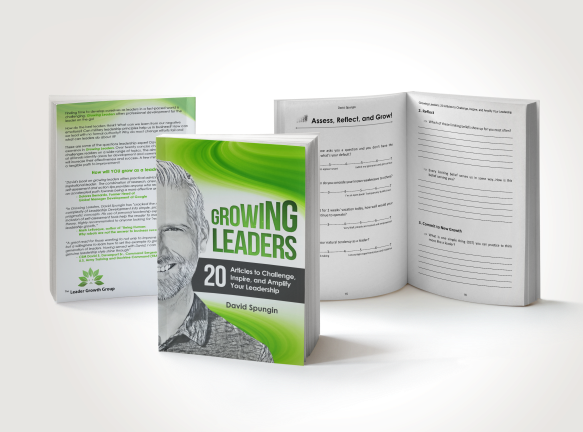
Should leaders wear masks?
You might be saying, “Of course, they should! No responsible person would risk spreading the COVID-19 virus, and leading by example is wearing your PPE when unable to social distance.”
Or, maybe you are thinking, “Leaders go against the tide! They also uphold fundamental values like freedom and aren’t swayed by popular opinion. Exercising personal liberty and not wearing a mask is an act of leadership.”
These are certainly strange times, and it’s likely you have an opinion on this important issue. However, these are not the kinds of masks I am speaking about. The reality is, leaders have always worn masks and they will continue to wear them well into the future.
If you’ve ever been in a leadership position, you already know this. With the responsibility of leadership comes high expectations from others. Like an actor, you are playing a role, and, so, you regularly put your mask on and go into character.
Here are some positive examples…
- You are nervous about meeting this quarter’s sales goals; however, you mask that fear and deliberately show up daily with an optimistic attitude in order to inspire (rather than deflate) your team.
- You are frustrated with a project’s “scope creep” and how the client is overworking/undercompensating members of your team. However, you mask that anger and calmly negotiate new terms that both preserve the relationship and your team’s sanity.
- You are surprised by a peer during cross-functional meeting when he publicly points out several areas where your team underdelivered. Rather than get defensive, you mask your feelings of betrayal and calmly exhibit curiosity/humility.
And here are some negative examples…
- You are overwhelmed with the relentless pace of working from home and trying to manage your home life simultaneously. However, you mask your stress level because you feel leaders should project composure and not show weakness. As a result, you miss opportunities to empathize and connect with your team members’ similar struggles.
- The news is relentlessly covering the death of George Floyd and the BLM protests. You notice a sadness in the room (and in yourself) at today’s staff meeting. Rather than talk about issues of diversity and inclusion firsthand with your team, you decide to mask these emotions by re-focusing the group on work execution.
Herein lies a significant challenge to leadership, knowing when wearing a mask serves us and when it will not.
Another way of stating the question might be: “When should a leader be authentic?”

Authenticity is widely considered as a cornerstone to effective leadership. However, the best leaders know the times wearing their masks are more important than being authentic! So, how do you know when to be authentic or to put your mask on?
To answer this question, we need to: 1) pay close attention to our emotions and 2) look to balance competency with a dash of vulnerability.
Notice that in all the examples provided, an emotion is being masked. Typically negative emotions like fear and anger don’t serve us as leaders. If not mindful, these emotions affect our physical presence (body language), choice of words (verbal communication), and diminish influence with others. If the emotion is not consistent with your role in the script, then mask up and go into character.
Still, like in the movies, most characters are flawed in some way! Those who desperately work to project pervasive competence come across as inauthentic. Look for moments when sharing your own vulnerabilities will demonstrate your humanity and help you to connect with others. Counterintuitively, you will earn greater respect and trust as a result.
We can use America’s mask debate as an example. No one is superhumanly immune to COVID-19 (without first having the virus). Thus, not wearing a mask in public can come across as inauthentic, like the leader is attempting to project invulnerability in order to make us feel safer. Wearing a mask in this situation is sharing the pain, it’s relating to the average citizen, it’s leadership!
 Finally, it’s important to note that most leaders err to the side of wearing a mask rather than being their authentic self. This is often because they haven’t practiced emotional intelligence (E.I.) and how to balance authenticity with desired impact. The bridge to effective authenticity is through deliberate E.I. development and coaching.
Finally, it’s important to note that most leaders err to the side of wearing a mask rather than being their authentic self. This is often because they haven’t practiced emotional intelligence (E.I.) and how to balance authenticity with desired impact. The bridge to effective authenticity is through deliberate E.I. development and coaching.
If you are interested in assessing your own Emotional Intelligence and discovering areas for personal development, check out this assessment.
Did you enjoy this article? If so, click the “follow” button above so you can receive future posts.

David Spungin designs/facilitates leadership programs for Fortune 500 organizations and is a coach to senior-level executives. As the Founder & Principal Consultant at The Leader Growth Group, he’s helped over 3000 leaders to inspire more engaged and productive workplaces. Get a copy of his book, “Growing Leaders: 20 Articles to Challenge, Inspire, and Amplify Your Leadership” by clicking here.
*All Rights Reserved. Reproduction, publication, and all other use of any and all this content is prohibited without the authorized consent of the author.








 David understands how effective leadership generates success. A U.S. Army combat veteran with corporate leadership experience, he is the Founder & Principal Consultant of The
David understands how effective leadership generates success. A U.S. Army combat veteran with corporate leadership experience, he is the Founder & Principal Consultant of The 

 David understands how effective leadership generates success. A U.S. Army combat veteran with corporate leadership experience, he is the Founder & Principal Consultant of The
David understands how effective leadership generates success. A U.S. Army combat veteran with corporate leadership experience, he is the Founder & Principal Consultant of The



 (David understands how effective leadership generates success. A U.S. Army combat veteran with corporate leadership experience, he is the Founder & Principal Consultant of
(David understands how effective leadership generates success. A U.S. Army combat veteran with corporate leadership experience, he is the Founder & Principal Consultant of 

 It’s No Longer Optional – In a world of information overload and multitasking, a leader’s attention is their most precious asset. One might think of attention as the currency of leadership, just like in your wallet or purse you have a finite amount of money you have available to spend. How you spend it is largely a function of your values/needs, and how a leader “spends” attention reflects their priorities. Unfortunately, in today’s VUCA world, it’s easy for leaders to spend their attention on distractions. Mindfulness is no longer optional; it is now a critical leader behavior.
It’s No Longer Optional – In a world of information overload and multitasking, a leader’s attention is their most precious asset. One might think of attention as the currency of leadership, just like in your wallet or purse you have a finite amount of money you have available to spend. How you spend it is largely a function of your values/needs, and how a leader “spends” attention reflects their priorities. Unfortunately, in today’s VUCA world, it’s easy for leaders to spend their attention on distractions. Mindfulness is no longer optional; it is now a critical leader behavior. Getting Beneath the Surface – With deliberately focused attention, the leader can dig deeper to see and to hear what might go on in their environment. Think of your daily workflow as moving like a fast-paced stream. The water is rushing by, and from the banks, you can see rocks and how they are affecting flow. Now, you take your hand and place it in the water. Immediately, you notice new information. The water is cooler and deeper than you expected. You also notice there is a strong undercurrent down about two feet. Similarly, leaders leverage mindfulness to observe, feel, sense, and think about what’s going on inside them and around them.
Getting Beneath the Surface – With deliberately focused attention, the leader can dig deeper to see and to hear what might go on in their environment. Think of your daily workflow as moving like a fast-paced stream. The water is rushing by, and from the banks, you can see rocks and how they are affecting flow. Now, you take your hand and place it in the water. Immediately, you notice new information. The water is cooler and deeper than you expected. You also notice there is a strong undercurrent down about two feet. Similarly, leaders leverage mindfulness to observe, feel, sense, and think about what’s going on inside them and around them. Seeing connections – With fresh information to work with, a mindful leader can practice greater curiosity and empathy. They might notice the VP of Sales sounded a little down on the call today and get curious about how he is holding up after almost three straight weeks of traveling. They may then remember he has a 5-year-old daughter at home, who has likely also been affected. Or a leader might notice their own frustration around why Project X hasn’t made more progress in recent weeks, only to realize they haven’t done a great job communicating expectations for certain milestones. Having connected the dots, the leader now has greater choice as to what leadership actions will increase their influence and produce results.
Seeing connections – With fresh information to work with, a mindful leader can practice greater curiosity and empathy. They might notice the VP of Sales sounded a little down on the call today and get curious about how he is holding up after almost three straight weeks of traveling. They may then remember he has a 5-year-old daughter at home, who has likely also been affected. Or a leader might notice their own frustration around why Project X hasn’t made more progress in recent weeks, only to realize they haven’t done a great job communicating expectations for certain milestones. Having connected the dots, the leader now has greater choice as to what leadership actions will increase their influence and produce results. Have you ever tried leading a person or a group without any formal authority to fall back on? For many, this is one of the greatest leadership challenges we might face. Without the traditional “
Have you ever tried leading a person or a group without any formal authority to fall back on? For many, this is one of the greatest leadership challenges we might face. Without the traditional “












 Leaders must recognize that this instinctual response to avoid accountability lives in their DNA; one can’t avoid it! Rather than attempting to circumvent this natural hard-wiring, it is best to bring awareness to it. Leaders see their reactivity, own it, and then prevent it from hijacking their thinking any further.
Leaders must recognize that this instinctual response to avoid accountability lives in their DNA; one can’t avoid it! Rather than attempting to circumvent this natural hard-wiring, it is best to bring awareness to it. Leaders see their reactivity, own it, and then prevent it from hijacking their thinking any further. 
 This post is a sample chapter from my new eBook “ACTIONABLE! Leadership: Develop Your Inspirational Ability, Motivate Teams, & Achieve Extraordinary Results.” Claim your free copy by following the below link and start taking action towards meeting your full leadership potential.
This post is a sample chapter from my new eBook “ACTIONABLE! Leadership: Develop Your Inspirational Ability, Motivate Teams, & Achieve Extraordinary Results.” Claim your free copy by following the below link and start taking action towards meeting your full leadership potential.